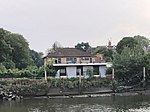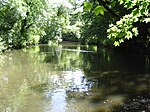St Margarets, London

St Margarets is a suburb and neighbourhood in the London Borough of Richmond upon Thames, about 9 miles (14 km) west-southwest of central London. It is bounded by the Thames Tideway to the north-east, and the River Crane to the north-west and north where the land tapers between these rivers. Land and buildings closer to Richmond Bridge than the eponymous railway station are, traditionally distinctly, known as East Twickenham. Both places go by their post town and traditional parish, Twickenham quite often; in the 19th century the south of St Margarets was marked on maps as Twickenham Park. The area hosts a house that J. M. W. Turner saw built during his painting career and St Margarets railway station is within 1⁄3 mile (0.54 km) of Marble Hill House. Uniquely in London among the few places prefixed Saint it is named after a house. Specifically it is named after a large house together with appurtenant land of an 18th century Scottish-English aristocrat, rather than a church which began in 1930.
Excerpt from the Wikipedia article St Margarets, London (License: CC BY-SA 3.0, Authors, Images).St Margarets, London
Ailsa Road, London St Margarets (London Borough of Richmond upon Thames)
Geographical coordinates (GPS) Address Nearby Places Show on map
Geographical coordinates (GPS)
| Latitude | Longitude |
|---|---|
| N 51.46 ° | E -0.32 ° |
Address
Ailsa Road
TW1 1QL London, St Margarets (London Borough of Richmond upon Thames)
England, United Kingdom
Open on Google Maps









